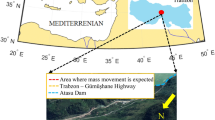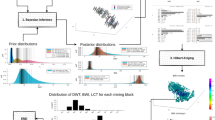Abstract
This article addresses the problem of the prediction of the breccia pipe elevation named Braden at the El Teniente mine in Chile. This mine is one of the world’s largest known porphyry-copper ore bodies. Knowing the exact location of the pipe surface is important, as it constitutes the internal limit of the deposit. The problem is tackled by applying a non-stationary geostatistical method based on space deformation, which involves transforming the study domain into a new domain where a standard stationary geostatistical approach is more appropriate. Data from the study domain is mapped into the deformed domain, and classical stationary geostatistical techniques for prediction can then be applied. The predicted results are then mapped back into the original domain. According to the results, this non-stationary geostatistical method outperforms the conventional stationary one in terms of prediction accuracy and conveys a more informative uncertainty model of the predictions.









Similar content being viewed by others
References
Almendral, A., Abrahamsen, P., & Hauge, R. (2008). Multidimensional scaling and anisotropic covariance functions. In: Proceedings of the eight international geostatistics congress (pp. 187–196).
Anderes, E. B., & Chatterjee, S. (2009). Consistent estimates of deformed isotropic gaussian random fields on the plane. Annals of Statistics, 37(5), 2324–2350.
Anderes, E. B., & Stein, M. L. (2008). Estimating deformations of isotropic gaussian random fields on the plane. Annals of Statistics, 36, 719–741.
Boisvert, J. B., & Deutsch, C. V. (2011). Programs for kriging and sequential gaussian simulation with locally varying anisotropy using non-euclidean distances. Computers & Geosciences, 37(4), 495–510.
Borg, I., & Groenen, P. (2005). Modern multidimensional scaling: Theory and applications. Springer Series in Statistics. Berlin: Springer.
Bornn, L., Shaddick, G., & Zidek, J. V. (2012). Modeling nonstationary processes through dimension expansion. Journal of the American Statistical Association, 107(497), 281–289.
Castro Morales, F., Gamerman, D., & Paez, M. (2013). State space models with spatial deformation. Environmental and Ecological Statistics, 20(2), 191–214.
Chilès, J. P., & Delfiner, P. (2012). Geostatistics: Modeling spatial uncertainty. New York: Wiley.
Cox, T., & Cox, A. (2000). Multidimensional scaling, (2nd ed.). New York: Taylor & Francis.
Damian, D., Sampson, P. D., & Guttorp, P. (2001). Bayesian estimation of semi-parametric non-stationary spatial covariance structures. Environmetrics, 12(2), 161–178.
Desassis, N., & Renard, D. (2012). Automatic variogram modeling by iterative least squares: Univariate and multivariate cases. Mathematical Geosciences, 45(4), 453–470.
Dryden, I. L., & Mardia, K. (1998). Statistical shape analysis. New York: Wiley.
Fouedjio, F., Desassis, N., & Romary, T. (2015). Estimation of space deformation model for non-stationary random functions. Spatial Statistics, 13, 45–61.
Genton, M. G., & Perrin, O. (2004). On a time deformation reducing nonstationary stochastic processes to local stationarity. Journal of Applied Probability, 41(1), 236–249.
Gneiting, T., & Raftery, A. E. (2007). Strictly proper scoring rules, prediction, and estimation. Journal of the American Statistical Association, 102(477), 359–378.
Iovleff, S., & Perrin, O. (2004). Estimating a nonstationary spatial structure using simulated annealing. Journal of Computational and Graphical Statistics, 13(1), 90–105.
Kruskal, J. B. (1964a). Multidimensional scaling by optimizing goodness of fit to a nonmetric hypothesis. Psychometrika, 29(1), 1–27.
Kruskal, J. B. (1964b). Nonmetric multidimensional scaling: A numerical method. Psychometrika, 29(2), 115–129.
Lloyd, C. (2010). Local models for spatial analysis (2nd ed.). New York: CRC Press.
Maksaev, V., Munizaga, F., McWilliams, M., Fanning, M., Mathur, R., Ruiz, J., et al. (2004). New chronology for El Teniente, Chilean Andes, from u-pb, 40ar/39ar, re-os, and fission-track dating: Implications for the evolution of a supergiant porphyry cu-mo deposit. Society of Economic Geologists Special Publication, 11, 15–54.
Mardia, K., & Goodall, C. (1993). Spatial-temporal analysis of multivariate environmental monitoring data. In G. P. Patil, & C. R. Rao (Eds.), Multivariate environmental statistics (vol. 16, pp. 347–386). North Holland: Elsevier Science Publishers, Ch.
McBratney, A. B., & Minasny, B. (2013). Spacebender. Spatial Statistics, 4, 57–67.
Meiring, W., Monestiez, P., Sampson, P. D., & Guttorp, P. (1997). Developments in the modelling of nonstationary spatial covariance structure from space-time monitoring data. In E. Y. Baafi, & N. A. Schofield (Eds.), geoENV II—Geostatistics for environmental applications. Quantitative geology and geostatistics (vol. 1, pp. 162–173). Dordrecht: Kluwer Academic Publisher.
Perrin, O., & Meiring, W. (1999). Identifiability for non-stationary spatial structure. Journal of Applied Probability, 36(4), 1244–1250.
Perrin, O., & Meiring, W. (2003). Nonstationarity in r-n is second-order stationarity in r-2n. Journal of Applied Probability, 40(3), 815–820.
Perrin, O., & Monestiez, P. (1998). Modeling of non-stationary spatial covariance structure by parametric radial basis deformations. In J. Gómez-Hernández, A. Soares, & R. Froidevaux (Eds.), geoENV II—Geostatistics for environmental applications. Quantitative geology and geostatistics (Vol. 11, pp. 175–186). Netherlands: Springer.
Perrin, O., & Senoussi, R. (2000). Reducing non-stationary random fields to stationarity and isotropy using a space deformation. Statistics & Probability Letters, 48(1), 23–32.
Porcu, E., Matkowski, J., & Mateu, J. (2010). On the non-reducibility of non-stationary correlation functions to stationary ones under a class of mean-operator transformations. Stochastic Environmental Research and Risk Assessment, 24(5), 599–610.
Sampson, P. D., & Guttorp, P. (1992). Nonparametric-estimation of nonstationary spatial covariance structure. Journal of the American Statistical Association, 87(417), 108–119.
Schmidt, A. M., Guttorp, P., & O’Hagan, A. (2011). Considering covariates in the covariance structure of spatial processes. Environmetrics, 22(4), 487–500.
Schmidt, A. M., & O’Hagan, A. (2003). Bayesian inference for non-stationary spatial covariance structure via spatial deformations. Journal of the Royal Statistical Society Series B-Statistical Methodology, 65, 743–758.
Skewes, M. A., Arévalo, A., Floody, R., Zuñiga, P. H., & Stern, C. R. (2002). The giant El Teniente breccia deposit: Hypogene copper distribution and emplacement. Soc. Econ. Geol. Spec. Publ., 9, 299–332.
Smith, R. L. (1996). Estimating nonstationary spatial correlations. Technical report, University of North Carolina.
Spencer, E. T., Wilkinson, J. J., Creaser, R. A., & Seguel, J. (2015). The distribution and timing of molybdenite mineralization at the El Teniente cu-mo porphyry deposit, Chile. Economic Geology, 110(2), 387–421.
Vera, J., Macias, R., & Angulo, J. (2008). Non-stationary spatial covariance structure estimation in oversampled domains by cluster differences scaling with spatial constraints. Stochastic Environmental Research and Risk Assessment, 22(1), 95–106.
Vera, J. F., Macias, R., & Angulo, J. M. (2009). A latent class mds model with spatial constraints for non-stationary spatial covariance estimation. Stochastic Environmental Research and Risk Assessment, 23(6), 769–779.
Wand, M., & Jones, C. (1995). Kernel smoothing. Monographs on statistics and applied probability. London: Chapman and Hall.
Zhang, H., & Wang, Y. (2010). Kriging and cross-validation for massive spatial data. Environmetrics, 21(3–4), 290–304.
Acknowledgments
We would like to thank the company CODELCO-Chile for providing the data used in this paper. We acknowledge the editor-in-chief of NARR for expert handling of our manuscript, and we thank the anonymous referees for their constructive comments.
Author information
Authors and Affiliations
Corresponding author
Rights and permissions
About this article
Cite this article
Fouedjio, F. Space Deformation Non-stationary Geostatistical Approach for Prediction of Geological Objects: Case Study at El Teniente Mine (Chile). Nat Resour Res 25, 283–296 (2016). https://doi.org/10.1007/s11053-015-9287-7
Received:
Accepted:
Published:
Issue Date:
DOI: https://doi.org/10.1007/s11053-015-9287-7




